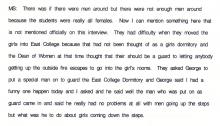The Housing Crisis
President William W. Edel reported the inadequate housing situation to the Board of Trustees. The president explained that the lack of housing in Carlisle made it difficult to attract prospective professors. Due to the fact that male students would not occupy the Gibbs House during the next academic year, the college planned to use it to house 20 female students. This change would mean that women students would reside in Metzger Hall, East College, and the Gibbs House.
East College to become women's dormitory
Chairman S. Walter Stauffer of the Committee on Grounds and Buildings presented his report on women's housing. He confirmed that East College would be renovated for female residents for the Fall Session as soon as the male students departed in June. The building would house approximately 100 women.
Converting East College
President Boyd Lee Spahr addressed the issue of housing for women in his report to the Board of Trustees. He proposed the use of East College as a women's dormitory in addition to Metzger Hall, explaining that these two buildings would house 171 women. He also proposed changing the Gibbs House from a women's dormitory to a residence for male students. The Board of Trustees approved this recommendation.
Renovating East College for Women over Summer
Dean Ernest A. Vuilleumier reported to the Board of Trustees that the college had rented two fraternity houses (Phi Delta Theta and Beta Theta Pi) in order to provide additional housing for female students. According to Vuilleumier, the return of fraternity members to campus would require that the college develop an alternative form of housing for female students. Therefore, the dean recommended that the college convert East College into a women's dormitory.
The Class of 1905 and "The Aftermath"
Edna Albert, class of 1905, served as the director for the preparation of "The Aftermath," a brochure of 113 pages recording the details of their class's 20th annual reunion. The brochure was illustrated by reunion pictures at East College, included official progroms of the class commencement of 1905, copies of correspondence leading up to the reunion, and a section entitled "Letters and Lives" which told of the fortunes of their graduating class.
Microcosm Looks into the Crystal Ball and Sees New Women's Dormitory
The 1949 Microcosm discussed the "Ten-Year Development Program" that President William W. Edel presented on the 175th Anniversary of the college. The yearbook reproduced excerpts from the speech. In one excerpt, President Edel admits that the female students' living quarters are old and that the college has provided no dormitory for the students since the institution became co-educational in 1884.
New Fad Sweeping the Nation
An issue of the Free Dickinsonian called for the college administration to tear down East College, or "Old East;" to require resident students, including women, to eat in the cafeteria; and to create a smoker's lounge. According to the Free Dickinsonian, there was a "new fad" during the 1940s: female smokers. Other colleges, like Williams College and Penn Hall School, had recognized this "new fad." The Free Dickinsonian argued that, in the next decade, the college should install a smoking lounge in Metzger Hall for the co-ed students.
Dorm Life during World War II
Winona Mensch Gray (Class of 1948) describes female dormitory life during World War II in an interview. Gray lived in Metzger Hall during her freshman and sophomore years. She was only one of two sophomores who lived in the hall. She describes Metzger Hall as an "old building with high ceilings." There was a dining room in the basement and wash basins down the hall for laundry. The dean of women lived on the second floor in an apartment. She remembers the beds being uncomfortable.
Move to East College creates problems for Dean of Women
Mary Louise Shuman, who attended Dickinson during World War II, reports in an interview that Dickinson College had difficulty when it moved female students to East College. According to Shuman, the dean of women was concerned because the building, which had not previously been a women's dormitory, had fire escapes; she worried that men would enter the dormitory via the fire escapes.









